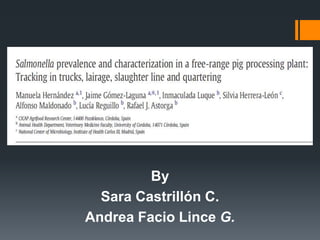
Salmonella prevalence and characterization in a free range pig
- 1. By Sara Castrillón C. Andrea Facio Lince G.
- 2. INTRODUCTION Belongs to the family of Enterobacteriaceae (enteric gram-negative bacilli). These are characterized by ferment glucose and mannose. S.Enterica and S. Borgori. S.Enterica is pathogenic to humans. Has 6 subspecies and several serotypes.
- 3. INTRODUCTION 2500 serotypes with capacity of producing salmonellosis have been discovered. Gateway: orally (bacteria colonizes intestinal mucous membrane Reservoir: Animals and Humans.
- 4. INTRODUCTION
- 5. OBJETIVE Determinate the prevalence of Salmonella spp. along a free-range pig production plant. oTrucks. oLairage. (TLSQ) oSlaughter line and Quartering. Genetically characterize the Salmonella isolates.
- 6. MATERIALES Y MÉTODOS MUESTRA Durante 2009 y 2010. 8 TLSQ. 10 Cerdos por manada. 6 diferentes estados en la línea de producción.
- 7. ESTADOS MUESTRAS ESTADO MUESTRAS Llegan al matadero Amígdalas i Camiones Después limpieza Nodos iv linfoides Desinfectados Contenido ii cecal Corrales Sucios Agua de escaldado Pre-escaldado (2) Agua de v esterilización Muestras del Post-escaldado ambiente (2) Cuchillos y hachas iii Post-flameado Mesas Post- evisceración vi Post- lavado Muestras de Carne descuartizamiento (2) Sacrificio y descuartizamiento.
- 8. MATERIALES Y MÉTODOS AISLAMIENTO E IDENTIFICACIÓN Recolección de la muestra en contenedores estériles. Se realizaron diluciones 1:10 con buffer de agua peptonada. Incubación 24 h a 37°C.
- 9. MATERIALES Y MÉTODOS AISLAMIENTO E IDENTIFICACIÓN Medio de cultivo. Confirmación por técnicas bioquímicas. Almacenamiento a -80°C
- 10. MATERIALES Y MÉTODOS PFGE (Electroforesis en Gel de Campo Pulsado) Para proteínas de gran tamaño. Varios pares de electrodos que pulsan secuencialmente por tiempos variables.
- 11. MATERIALES Y MÉTODOS PFGE (Electroforesis en Gel de Campo Pulsado) Cambio de dirección del campo eléctrico despliega las proteínas. A menor peso más rápido es el movimiento.
- 12. RESULTADOS TOTAL MUESTRAS TOTAL AISLADOS DE RECOLECTADAS Salmonella 1160 126 (10.86%) TLSQ CEPAS 1 S. Derby 2 S. Rissen 4 S. Bredeney 3, 5, 6, 7, 8 Diferentes serotipos
- 13. RESULTADOS
- 14. RESULTADOS RESULTADOS SEROTIPOS FRECUENCIA S. Bredeney 37 S. Rissen 35 S. Derby 25
- 15. RESULTADOS PFGE fue usada para caracterizar el genotipo del serotipo de Salmonella del ambiente y los cerdos. TLSQ1 Derby. TLSQ2 Rissen. TLSQ4 Bredeney.
- 17. RESULTADOS
- 20. RESULTADOS
- 21. DISCUSSION RESEARCHER WHAT THEY SAID YES OR NO Slaughter line is an important source of Swannenburg et al. Salmonella YES contamination for pig carcasses. Phage types 104, 193 and 120 are Anon frequently isolated in YES human cases of salmonellosis.
- 22. DISCUSSION RESEARCHER WHAT THEY SAID YES OR NO Reported the role of transport, lairage and slaughter line equipment in the Mannion et al. dissemination of YES Salmonella in pigs in the pre- and post- slaughter environments. Cross contamination from transport or Kirchner et al. YES lairage to pigs or vice versa.
- 23. CONCLUSIONS Increase the cleaning and disinfection process in order to reduce the risk to acquire Salmonella. The prevalence of Salmonella in Slaughtering process have an impact in consumers health, generating diarrhea and vomiting.
- 24. CONCLUSIONS The pig slaughtering process have to create check points in every steps of the process. Actually organic and eco-friendly food has an important role in consumer, but this will generated a higher cost in biosecurity.
- 25. MAPAS
- 26. MAPAS
- 27. GRACIAS